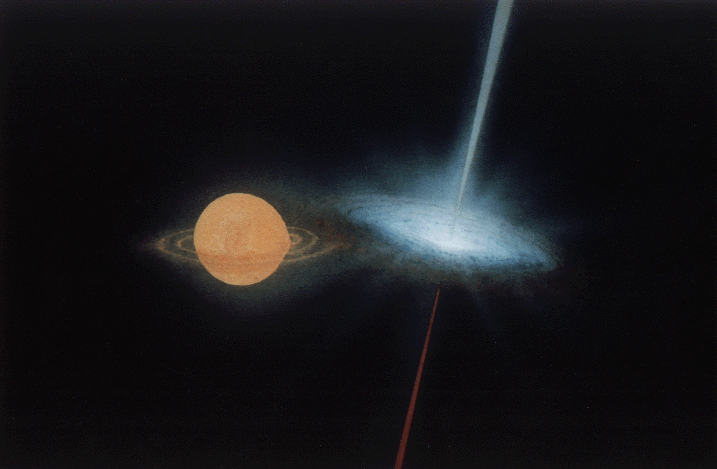June 9, 2015 report
Researchers characterize mysterious ultraluminous X-ray sources

(Phys.org)—Many black holes are believed to have surrounding accretion disks of matter trapped by gravity and spiraling toward the event horizon. Supercritical accretion disks (SCADs) are those with mass accretion rates exceeding the Eddington limit—this describes the maximum possible luminosity of an energetic body when the outward force of radiation is in equilibrium with gravitation. Masses that exceed the Eddington luminosity to produce SCADs emit extremely intense stellar winds from their outer layers.
The only known supercritical accretor in the Milky Way galaxy is SS 433, a highly exotic eclipsing binary star system. Its primary object is likely a black hole. Its secondary companion is believed to be a late A-type star based on its light spectrum. The secondary in SS 433 is losing mass into an accretion disk as it spirals in toward the primary, which is slowly consuming it. In turn, as the accretion disc spirals in toward the primary, it becomes super-heated and emits intense X-rays.
Physicists are fascinated by the exotic nature of SS 433, but also by its strong resemblance to ultraluminous X-ray sources (ULXs), which are astronomical sources of X-rays that are less luminous than the nuclei of active galaxies, but are more luminous than any known stellar process. These are sources of X-rays that exceed the Eddington luminosities of neutron stars and stellar black holes. Recently, a group of researchers from Russia and Japan have compared the optical spectra of ULXs to SS 433 and have determined that ULXs with X-ray luminosities of ~1040 erg S-1 must constitute a homogenous class of objects that most likely have SCADs. They have published their results in Nature Physics.
The most popular models for ULXs have either intermediate mass black holes with standard accretion disks or stellar-mass black holes with accretion disk luminosity exceeding the Eddington limit. Based on X-ray data alone, it is not possible to distinguish these models, so the researchers have turned to optical spectroscopy to find unique information about ULXs. Using the 8.2 meter Subaru Telescope of the National Astronomical Observatory of Japan, located at the Mauna Kea Observatory on Hawaii, they obtained high-quality spectroscopic data from a number of ULX sources.
They have determined that ULX spectra are quite similar to late nitrogen Wolf-Rayet stars (WNLs), which exhibit broad emissions of ionized nitrogen and helium or carbon. They have very high surface temperatures and produce intense stellar winds. The spectra from ULXs also resemble those of luminous blue variable stars (LBVs) in the compact stages of stellar development. Because the physical conditions of its disk wind may be similar to WNL stars, SS 433 also bears a strong resemblance to ULXs. The authors write, "Such spectra of high luminosities with prominent He II emission lines have never been observed from any stellar-mass black hole X-ray binaries, except for SS 433 and those having WNL donors [secondaries losing mass to the accretion disks of primaries in binary systems]."
They exclude a number of stellar cases, including ULXs with WNL donors that exhibit stellar winds with the observed spectra. Wind terminal velocity is determined by surface gravity, making it difficult to explain the rapid variability of the He II line width in the recorded spectra. The authors conclude that SS 433 is intrinsically the same as ULXs, but is an extreme case with a particularly high mass accretion rate from its secondary, which accounts for the presence of its persistent jet outflows.
More information: "Supercritical accretion disks in ultraluminous X-ray sources and SS 433." Nature Physics (2015) DOI: 10.1038/nphys3348
Abstract
The black hole mass and accretion rate in ultraluminous X-ray sources (ULXs) in external galaxies, whose X-ray luminosities exceed those of the brightest black holes in our Galaxy by hundreds and thousands of times1, 2, is an unsolved problem. Here we report that all ULXs ever spectroscopically observed have almost the same optical spectra, apparently of WNL type (late nitrogen Wolf–Rayet stars) or LBV (luminous blue variables) in their hot state, which are very scarce stellar objects. We show that the spectra do not originate from WNL/LBV-type donors but from very hot winds from the accretion disks with nearly normal hydrogen content, which have similar physical conditions to the stellar winds from these stars. The optical spectra are similar to that of SS 433, the only known supercritical accretor in our Galaxy3, although the ULX spectra indicate a higher wind temperature. Our results suggest that ULXs with X-ray luminosities of ~1040 erg s−1 must constitute a homogeneous class of objects, which most likely have supercritical accretion disks.
Journal information: Nature Physics
© 2015 Phys.org





















